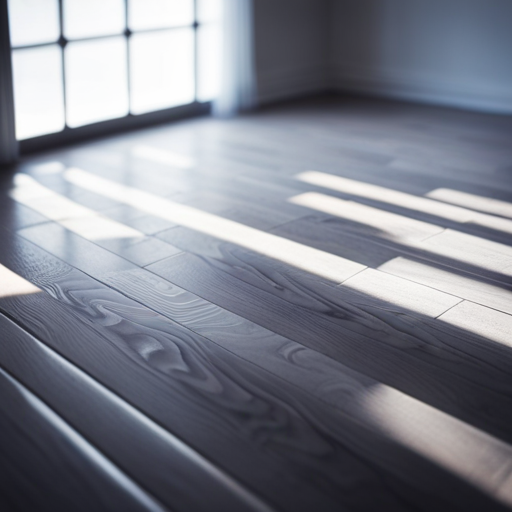Incorporating Sustainable Flooring in Your Design

Looking to elevate your design while minimizing your environmental impact? Incorporating sustainable flooring in your design is a key step towards creating a more eco-friendly space.
From the benefits of sustainable flooring to considerations for choosing the right materials, this article will provide you with the insights and tips you need to seamlessly integrate sustainable flooring into your design projects.
Discover how to create beautiful, sustainable spaces without compromising on style or functionality.
Benefits of Sustainable Flooring
While there are various types of flooring available, incorporating sustainable flooring in your design offers numerous benefits for both the environment and your indoor space.
Sustainable flooring, such as bamboo, cork, or reclaimed wood, is not only environmentally friendly but also offers cost savings in the long run. These materials are often durable and require less maintenance, reducing the need for frequent replacements and repairs. Additionally, sustainable flooring options contribute to a healthier indoor environment by minimizing the release of harmful chemicals commonly found in non-sustainable flooring materials. This can lead to improved indoor air quality and reduced health risks for occupants.
From an environmental standpoint, sustainable flooring materials are sourced and manufactured using eco-friendly processes, minimizing their overall impact on the planet. This supports the conservation of natural resources and reduces the carbon footprint associated with traditional flooring production. By choosing sustainable flooring, individuals can contribute to the promotion of sustainability and the preservation of natural ecosystems.
Types of Sustainable Flooring Materials
The use of sustainable flooring materials is exemplified by a variety of options, each offering unique characteristics and benefits for environmentally conscious design.
Bamboo flooring is a popular choice due to its rapid renewability and durability. It is also an attractive option for its aesthetic appeal and versatility in various design schemes.
Cork flooring is another sustainable option known for its natural insulating properties, resilience, and sound absorption capabilities. Additionally, cork is harvested from the bark of cork oak trees, allowing the trees to continue growing and providing a renewable source.
Recycled materials, such as reclaimed wood or recycled metal tiles, offer sustainable flooring options that repurpose materials and reduce waste. These materials add a distinctive and eco-friendly element to design projects.
Non-toxic options, such as natural linoleum and wool carpeting, are free from harmful chemicals often found in traditional flooring materials. These alternatives prioritize indoor air quality and promote a healthier living environment.
When considering sustainable flooring, these options present environmentally friendly choices that align with a commitment to sustainable design.
Considerations for Choosing Sustainable Flooring
When choosing sustainable flooring, it’s essential to consider the eco-friendly options available for materials. Some examples of these materials include bamboo, cork, reclaimed wood, and linoleum.
Additionally, it’s important to assess the long-term environmental impact of the flooring. This includes factors such as its durability, recyclability, and energy consumption during production and installation.
Material Eco-Friendly Options
Selecting eco-friendly flooring materials involves careful consideration of the environmental impact, durability, and maintenance requirements to ensure a sustainable design. When choosing sustainable flooring options, it’s essential to opt for materials that contribute to green building and are derived from renewable resources. Here are some eco-friendly flooring options to consider:
-
Bamboo: A fast-growing grass that can be harvested without killing the plant.
-
Cork: Derived from the bark of cork oak trees, which regenerate every few years.
-
Reclaimed Wood: Salvaged from old buildings, offering a unique and sustainable flooring option.
-
Linoleum: Made from natural materials like linseed oil, pine rosin, and wood flour.
-
Recycled Glass Tiles: These tiles are created from recycled glass, providing a durable and environmentally friendly flooring option.
Long-Term Environmental Impact
Considerations for choosing sustainable flooring should prioritize long-term environmental impact.
To assess this impact, conducting a carbon footprint analysis is crucial. This analysis evaluates the total greenhouse gas emissions produced directly and indirectly throughout the lifecycle of the flooring material.
Additionally, seeking out environmental certifications such as Forest Stewardship Council (FSC) or Leadership in Energy and Environmental Design (LEED) can help ensure the long-term sustainability of the chosen flooring. These certifications provide assurance that the flooring meets specific environmental performance criteria and has been responsibly sourced.
Incorporating Sustainable Flooring in Different Rooms
The use of sustainable flooring materials in various rooms of a building is an essential aspect of environmentally conscious interior design. When it comes to incorporating sustainable flooring in different rooms, there are several eco-friendly options to consider:
-
Kitchen: Opt for sustainable flooring materials such as bamboo, cork, or reclaimed wood. These materials are durable, easy to clean, and sustainable choices for kitchen spaces.
-
Bedroom: Choose eco-friendly flooring options like natural linoleum, recycled carpet tiles, or sustainably sourced hardwood. These materials are non-toxic and contribute to a healthy indoor environment.
-
Living Room: Consider using reclaimed hardwood, which adds warmth and character to the space while promoting sustainable practices.
-
Bathroom: Explore options like recycled glass tiles, natural stone, or sustainably sourced ceramic tiles for a stylish and eco-friendly flooring solution in the bathroom.
-
Home Office: Sustainable options such as cork flooring or FSC-certified hardwood can create a comfortable and eco-friendly workspace.
By incorporating sustainable flooring materials in different rooms of a building, you can create a harmonious and environmentally friendly living space.
Now, let’s delve into the essential maintenance and care for sustainable flooring.
Maintenance and Care for Sustainable Flooring
Proper maintenance and care of sustainable flooring is crucial to preserving its longevity and eco-friendly attributes across various rooms in a building. When it comes to cleaning techniques for sustainable flooring, it is essential to use non-toxic and eco-friendly cleaning products. Harsh chemicals can degrade the natural finishes and harm the environment.
Regular sweeping and vacuuming can help prevent dirt and debris from scratching the floor’s surface. For deeper cleaning, damp mopping with a neutral pH cleaner specifically designed for the type of sustainable flooring is recommended. It is important to avoid excessive water and moisture, as it can damage the flooring material.
Additionally, promptly cleaning up spills and avoiding dragging heavy furniture across the floor can prevent damage and maintain the flooring’s natural beauty.
When it comes to natural finishes, routine maintenance such as resealing or re-oiling, depending on the type of finish, can help protect the flooring from wear and tear while also enhancing its sustainability.
Eco-Friendly Design Tips for Sustainable Flooring
An article determiner helps to provide the necessary context for the reader. When it comes to eco-friendly design tips for sustainable flooring, there are several key considerations to keep in mind for green building and eco-conscious design. Here are some essential tips to incorporate sustainable flooring into your design:
-
Choose Renewable Materials: Opt for flooring materials that are rapidly renewable, such as bamboo, cork, or reclaimed wood. These materials have a lower environmental impact and can be replenished relatively quickly.
-
Look for Recycled Content: Select flooring products that contain recycled content, such as recycled glass tiles or recycled metal tiles. Using recycled materials helps reduce the amount of waste in landfills and conserves natural resources.
-
Prioritize Low-Emission Options: Select flooring products with low volatile organic compound (VOC) emissions to improve indoor air quality. Look for eco-friendly adhesives and finishes to minimize off-gassing and promote a healthier environment.
-
Consider Durability and Longevity: Choose flooring materials that are durable and long-lasting to minimize the need for frequent replacements. This helps reduce waste and conserves resources over time.
-
Opt for Energy-Efficient Production: Research the production processes of different flooring materials and opt for options that are manufactured using energy-efficient and environmentally friendly methods.
Frequently Asked Questions
How Can I Ensure That the Sustainable Flooring I Choose Is Durable and Long-Lasting?
To ensure the durability and longevity of sustainable flooring, it’s important to follow maintenance tips provided by the manufacturer. Consider the environmental impact, compare costs, and carefully follow the installation process for optimal results.
Are There Any Specific Installation Considerations for Sustainable Flooring That I Should Be Aware Of?
When it comes to sustainable flooring, specific installation considerations are essential. Proper subfloor preparation and following manufacturer guidelines are crucial. Maintenance requirements may include using environmentally friendly cleaning products and regular inspections for wear and tear.
What Are Some Common Misconceptions About Sustainable Flooring That I Should Be Aware Of?
Common misconceptions about sustainable flooring include doubts about durability and limited design options. In reality, sustainable flooring offers a wide range of durable, aesthetically pleasing options that are cost-effective, have low maintenance requirements, and positively impact the environment.
Can I Use Sustainable Flooring in High-Traffic Areas of My Home or Commercial Space?
Sustainable flooring can be used in high-traffic areas, offering durability and environmental benefits. Proper installation techniques, adherence to certification standards, and dispelling misconceptions with facts are crucial for maximizing the advantages of sustainable flooring.
Are There Any Governmental or Industry Certifications I Should Look for When Choosing Sustainable Flooring Materials?
When choosing sustainable flooring materials, it’s crucial to look for governmental or industry certifications. These certifications ensure that the flooring meets specific environmental impact, sustainability, and durability standards. Consider installation considerations and misconceptions, especially in high-traffic areas in both home and commercial spaces.
Conclusion
In conclusion, sustainable flooring offers numerous benefits for environmentally conscious design, with a variety of materials and considerations to keep in mind.
By incorporating sustainable flooring in different rooms and maintaining it properly, you can create an eco-friendly living space.
When choosing sustainable flooring, consider the long-term impact on the environment and the overall aesthetic of your design.
By making informed choices, you can create a beautiful and sustainable living space that reflects your commitment to environmental responsibility.
Choose sustainability for a greener future.

Rubin Everest, a seasoned expert in the world of flooring, brings a wealth of knowledge and passion to the surface. As the mind behind ebbow.com, Rubin is dedicated to sharing insights on the latest trends, innovative solutions, and expert advice in the realm of flooring. Whether you’re seeking practical tips for installation or design inspiration, Rubin Everest is your go-to source for all things flooring-related, making your journey to the perfect floor an informed and enjoyable experience.





